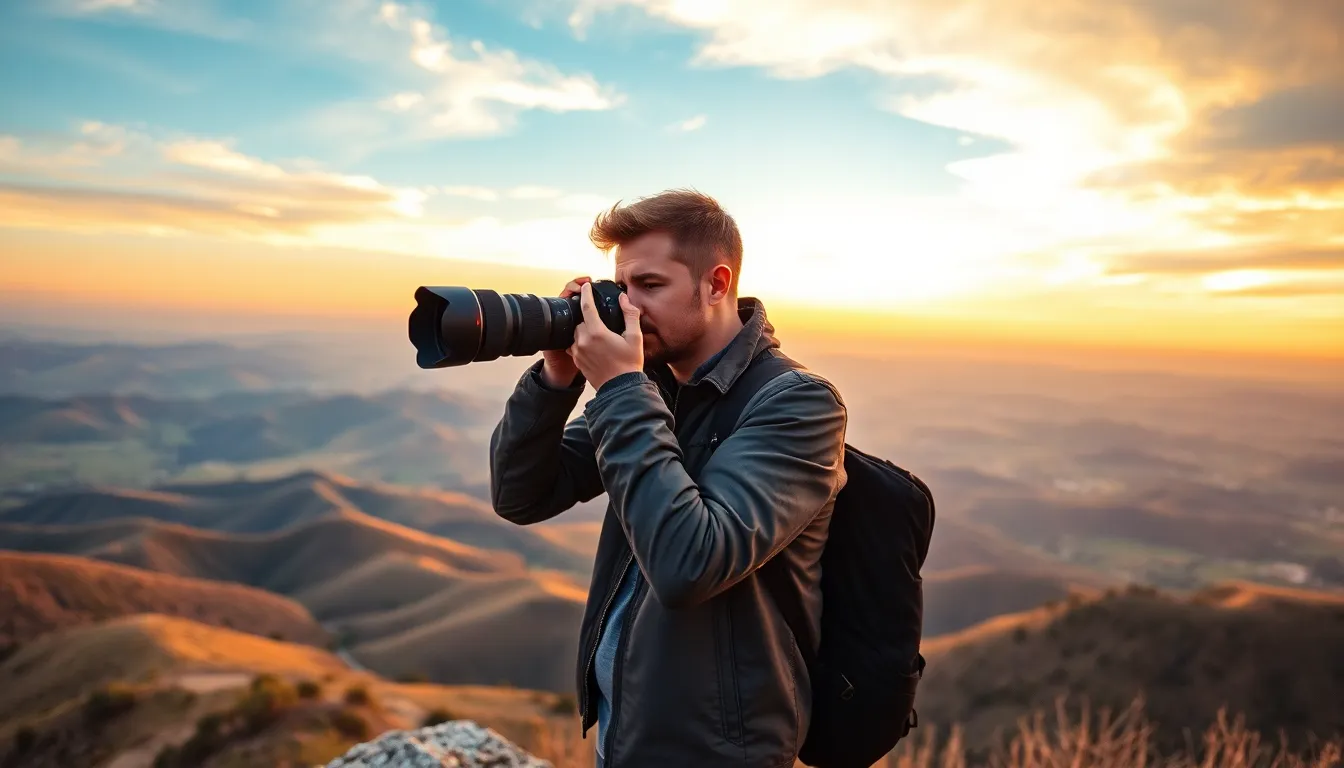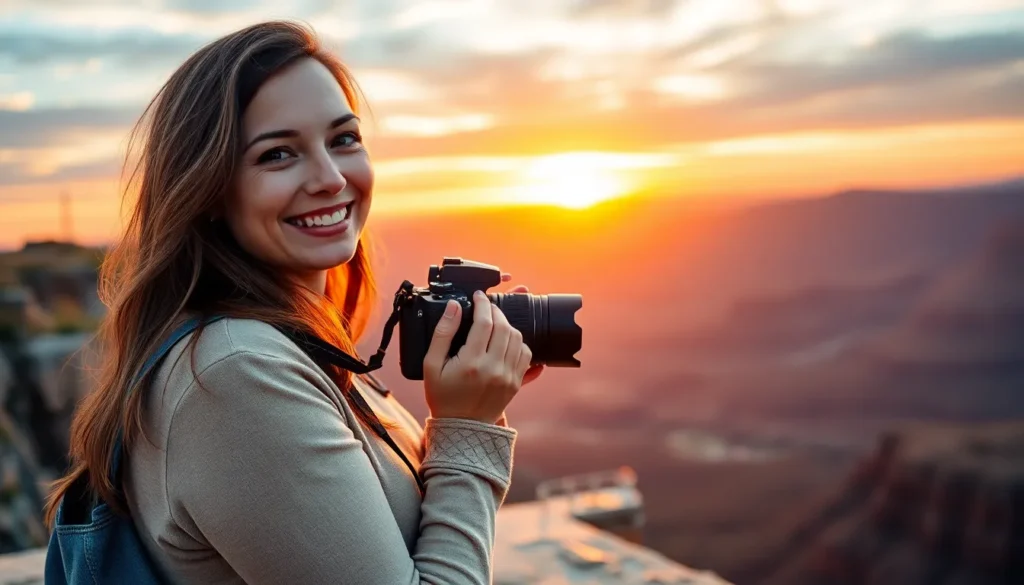Travel photography is all about capturing those breathtaking moments that make the journey unforgettable. But let’s face it, the right lens can turn a good shot into a jaw-dropping masterpiece. Whether it’s the stunning landscapes of the Grand Canyon or the bustling streets of Tokyo, having the best lens in your camera bag can mean the difference between a blurry mess and a postcard-perfect image.
Imagine lugging around a suitcase full of lenses only to realize you’ve packed the wrong one for that epic sunset. Talk about a travel fail! Choosing the right lens not only lightens the load but also ensures you’re ready for anything, from sweeping vistas to close-up shots of street food. So, buckle up as we dive into the world of travel photography lenses that’ll have you snapping like a pro and maybe even earning a few jealous glances along the way.
Best Lens For Travel Photography
Travel photography captures moments and experiences in diverse locations. Selecting the right lens plays a critical role in achieving stunning images.
What Makes a Great Travel Lens?
A great travel lens combines versatility and portability. It enables photographers to adapt to various scenes, from sweeping landscapes to urban architecture. Compact designs facilitate easy transport, making it simpler to carry throughout journeys. Additionally, a great lens showcases excellent image quality, producing sharp, vivid colors. Constant maximum aperture contributes to effective low-light performance, ensuring clarity in dim conditions. Ultimately, a suitable travel lens empowers photographers to seize spontaneous moments without compromise.
Key Features to Consider
Several key features enhance a lens’s performance in travel photography. Focal length flexibility allows for creativity across different environments. Wide apertures benefit low-light situations while improving depth of field. Robust weather sealing protects against environmental factors such as dust or moisture. Image stabilization decreases blur caused by camera movement, improving overall image sharpness. Compactness and lightweight construction ensure comfort during lengthy treks. Understanding these features aids photographers in making informed choices before embarking on their adventures.
Types of Lenses for Travel Photography

Selecting the right lens enhances travel photography significantly. Various types of lenses cater to different scenarios, making it easier to capture breathtaking images on the go.
Wide-Angle Lenses
Wide-angle lenses excel at capturing expansive landscapes and architectural details. Focal lengths typically range from 10mm to 24mm, making these lenses ideal for fitting more into the frame. Many photographers use wide-angle lenses to convey a sense of space and depth. Low-light performance is often adequate, ensuring balanced exposures in challenging conditions. A popular option, the 16-35mm lens, combines versatility with excellent image quality, catering to both scenery and group shots. Ultimately, this lens type allows travelers to document vast vistas authentically.
Zoom Lenses
Zoom lenses offer adaptability, accommodating various shooting conditions without needing to switch lenses. These lenses typically cover focal lengths from 18mm to 200mm or more, providing flexibility for both wide angles and detailed close-ups. Many travelers appreciate the convenience of carrying one zoom lens rather than multiple fixed lenses. A well-known option, the 24-70mm f/2.8 lens, allows for sharp images across focal lengths. Weather-sealed designs often provide added durability, ensuring the lens withstands the elements during adventures. Zoom lenses simplify the travel experience while ensuring high-quality photography.
Prime Lenses
Prime lenses deliver exceptional optical quality and bright apertures, making them essential for low-light situations. Fixed focal lengths, such as 35mm or 50mm, encourage creativity by prompting photographers to think critically about composition. Many photographers choose prime lenses for portraits and street photography due to their shallow depth of field, which creates pleasing bokeh. These lenses are typically more compact and lighter, enhancing portability. A 50mm f/1.8 lens serves as a popular choice, balancing quality with affordability while delivering sharp images. Prime lenses inspire spontaneity while capturing captivating moments.
Top Recommendations for Best Lens for Travel Photography
Selecting the right lens enhances travel photography. Below are top recommendations based on prevalent brands.
Canon Lenses
Canon’s EF 24-70mm f/2.8L II USM lens offers versatility, covering a range of scenarios from landscapes to portraits. This lens maintains excellent image quality across its zoom range. Photographers benefit from its weather-sealing, ensuring durability in various conditions. The wide f/2.8 aperture allows for impressive low-light performance.
Another excellent option is the EF 16-35mm f/4L IS USM. This wide-angle lens excels in capturing expansive vistas and crowded scenes, making it ideal for travel photography. It includes image stabilization for sharper images at slower shutter speeds.
Nikon Lenses
Nikon’s AF-S NIKKOR 24-120mm f/4G ED VR is a solid choice for its balance of zoom capability and portability. It has a constant f/4 aperture, ensuring consistent shooting quality in changing light. Image stabilization helps reduce blur during handheld shooting.
For those focusing on landscapes, the AF-S NIKKOR 14-24mm f/2.8G ED proves invaluable. Its ultra-wide angle lets photographers capture sweeping vistas with remarkable clarity. The robust construction protects against harsh elements, which is crucial for outdoor environments.
Sony Lenses
For Sony users, the FE 24-70mm f/2.8 GM lens stands out for its exceptional sharpness and versatility. This lens easily transitions between different shooting styles, accommodating varied subjects from landscapes to close-ups.
The FE 16-35mm f/2.8 GM lens provides impressive wide-angle performance, perfect for dynamic travel shots. It generates stunning detail while maintaining a compact form factor, allowing for easy transport. Both lenses embody features suited for professional-quality travel photography.
Tips for Using Your Travel Lens
Using the right travel lens not only enhances image quality but also simplifies your photography experience. By applying effective techniques, photographers can maximize their lens potential.
Composition Techniques
Rule of thirds remains a fundamental guideline; placing subjects along these lines or their intersections creates balanced photos. Leading lines guide the viewer’s eye, directing attention toward focal points. Framing adds depth, so consider incorporating natural elements like trees or doorways. Experiment with varying perspectives to present familiar scenes in new ways, and don’t overlook the power of negative space to emphasize subjects. Lastly, use a shallow depth of field to isolate subjects, yielding stunning portraits and details against soft backgrounds.
Adaptability in Various Conditions
Flexibility in choosing when and how to shoot proves essential in travel photography. Adapting to changing light conditions requires quick adjustments; increase the ISO to maintain clarity in low-light situations. Portable, lightweight lenses offer ease of use without sacrificing quality, enabling spontaneous shooting. Weather-sealed lenses stand up against rain or dust, ensuring a seamless experience during outdoor adventures. Shifting between focal lengths within zoom lenses permits quick compositions without changing gear. Prioritizing adaptability helps capture diverse scenes effortlessly, ensuring no moment goes undocumented.
Conclusion
Choosing the right lens for travel photography can significantly enhance the quality of images captured during adventures. With options like wide-angle lenses for breathtaking landscapes and versatile zoom lenses for various scenarios, photographers can find the perfect fit for their needs.
Prioritizing features such as portability and low-light performance ensures that every moment is captured beautifully. By understanding the unique strengths of each lens type and employing effective composition techniques, photographers can document their travels in a way that tells a compelling story. Ultimately, the right lens not only elevates the photography experience but also allows for unforgettable memories to be preserved in stunning detail.



